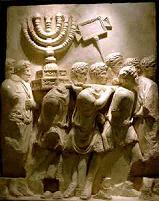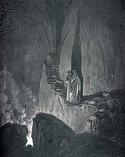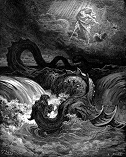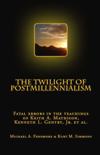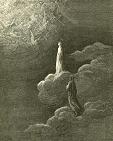The Eschatological Harvest
and the Man of Sin
Kurt M. Simmons
In his second epistle to the Thessalonians,
Paul mentions a “gathering” of the saints unto the Lord at his
coming:
“Now we beseech you, brethren, by the coming of
our Lord Jesus Christ, and by our gathering together unto him, that
ye be not soon shaken in mind, or be troubled, neither by spirit,
nor by word, nor by letter as from us, as that the day of Christ is
at hand.” (II Thess.
2:1)
In this article we will attempt to identify
what this eschatological “gathering” was and how it was
accomplished.
Old Testament Origins
Most, if not all, of the sacred feasts of the
Jews had redemptive and eschatological significance, looking forward
to the time when man would be loosed from the bondage of sin and
death and receive his heavenly inheritance.
Among these, the Jubilee was perhaps foremost.
Every fifty years, on the Day of Atonement, the Jews were
commanded to sound trumpets throughout the land and every man who
was indebted or under bondage was freed to return to his paternal
possession and family.
(Lev. 25:10, 11; cf. Lev. 16) A man’s paternity was his family’s
ancestral land, granted in the original enumeration of the
congregation of
“In that day the Lord with his sore and great and
strong sword shall punish leviathan the piercing serpent, even
leviathan that crooked serpent; and he shall slay the dragon that is
in the sea…And it shall come to pass in that day, that the Lord
shall beat off from the channel of the river unto the stream of
Egypt and ye shall be gathered one by one, O ye children of Israel.
And it shall come to pass in that day, that the great trumpet
shall be blown, and they shall come which were ready to perish in
the
Leviathan was the world civil power opposing
the people of God, bringing the scourge of captivity and death, here
“Immediately after the tribulation of those days
shall the sun be darkened, and the moon shall not give her light,
and the stars shall fall from heaven, and the powers of the heavens
shall be shaken: And then shall appear the sign of the Son of man in
heaven: and then shall all the tribes of the earth mourn, and they
shall see the Son of man coming in the clouds of heaven with power
and great glory. And he
shall send his angels with a great sound of trumpet, and they shall
gather together his elect from the four winds, from one end of
heaven to the other.”
(Matt. 24:29-31)
Figurative Use to Describe Eschatological
Harvest
The word “gather” both here (Matt. 24:31) and
in II Thessalonians is from the Greek “episunago.”
The root of this word (sunago) occurs in several passages
where it is used figuratively in an agricultural context, describing
the eschatological gathering of God’s people.
Thus, John the Baptist said “I indeed baptize you with water
unto repentance: but he that cometh after me is mightier than I,
whose shoes I am not worthy to bear: he shall baptize you with the
Holy Ghost and with fire: whose fan is in his hand, and he will
throughly purge his floor, and gather (sunadzei) his wheat into the
garner; but he will burn up the chaff with unquenchable fire.”
(Matt. 3:11, 12)
Similarly, in the parable of the wheat and the
tares, Jesus used the term, saying, “and in the time of harvest I
will say to the reapers, Gather ye together first the tares and bind
them in bundles to burn them: but gather (sunagagete) the wheat into
my barn.” (Matt. 13:30;
cf. 40, 41)
The “burning up” of the chaff and tares
occurred in the destruction of the Jewish state and polity in A.D.
70 as prophesied by the Lord.
(Matt. 23-25; Mk. 14:62; Lk. 23:27-31; cf. Zech. 14:1-3; Mal.
3:2; 4:1-5) But, what
about the eschatological gathering of the saints, to what did this
refer? It cannot point
to preaching the gospel and gathering believers into the church, for
sowing the seed of the kingdom refers to preaching and the harvest
to the end of the age.
(Matt. 13:36-43; cf. 1-23) Hence, something else must be in view.
We would suggest that the eschatological gathering pointed to
the harvest of the saints by martyrdom in the persecution under Nero
and the Jews. This is
readily seen in the imagery of Revelation chapter fourteen.
Revelation Fourteen and the Harvest of the
Earth
Revelation chapter fourteen portrays the
harvest of the earth.
In Revelation, the “earth” is set in contradistinction to the “sea.”
The earth is a symbol for
After warning against succumbing to the
inquisitorial power of the beast and false prophet (vv. 9, 10), we
read: “Here is the patience of the saints…And I heard a voice from
heaven saying unto me, Write, Blessed are the dead which die in the
Lord from henceforth: Yea, saith the Spirit, that they may rest from
their labours; and their works do follow them.”
(Rev. 14:12, 13)
The assurance of blessing and rest after their trials and martyrdom
is followed by the image of Christ reaping the earth with a sickle:
“And I looked, and behold a white cloud, and upon the cloud
one sat like unto the Son of man, having on his head a golden crown,
and in his hand a sharp sickle.
And another angel came out of the temple, crying with a loud
voice to him that sat on the cloud, Thrust in thy sickle, and reap:
for the harvest of the earth is ripe.”
(vv.14, 15)
The marginal rendering of the term “ripe” is
“dried,” reflecting the fact that this is a harvest of wheat or
grain. Wheat is the
first grain to be harvested in spring and therefore made up the
"first fruits." (Ex.
34:22) Those being
reaped are the hundred forty and four thousand, dying in martyrdom
under the inquisition in
The Eschatological Harvest and the Man of
Sin
The discussion above is corroborated by the
context of II Thessalonians.
A cursory reading of II Thess. 2:1-12 will show that the
church in Thessalonica was alarmed that the day of the Lord was
immediately upon them.
But Paul admonishes them not to be “troubled” or “shaken in mind”
for the time of their gathering unto the Lord was not yet at hand.
First there would be a “falling away,” pointing to the full
and final rejection of Christ by the Jews, manifested in the
persecution of the church and a turning back to Judaism from the
gospel. The book of
Hebrews, written some years later, indicates that his process was
then underway when it alluded to the temptation to forsake the
church’s wonted time of assembly and turn back to Judaism.
(Heb. 10:23ff)
However, the day of national reckoning could be seen approaching and
the writer could say “For yet it is a very, very little while, and
he that shall come will come, and will not tarry.”
(Heb. 10:37)
James testifies of similar conditions in
The persecution that would mark the full and
final rejection of Christ by the Jews would arise under one Paul
refers to as the “man of sin” and “son of perdition.”
(II Thess. 2:3)
This individual would oppose and exalt himself above all that is
called God or worshipped, arrogating to himself divinity, usurping
the very throne of God in his heart (referred to figuratively as
“sitting in the temple of God;” cf. Ezek. 28:1, 2).
This refers to Nero Caesar and his war against Christ and the
church. However, Paul
reminds his readers that there was then something preventing Nero’s
and the Jews’ persecution:
“And now ye know what withholdeth that he might be revealed
in his time. For the
mystery of iniquity doth already work: only he who now letteth will
let, until he be taken out of the way.
And then shall that wicked be revealed, whom the Lord shall
consumed with the spirit of his mouth, and shall destroy with the
brightness of his coming.”
(II Thess. 2:7, 8)
Paul refers here to Claudius Caesar.
Claudius reigned from A.D. 41-54.
While he ruled, Claudius provided a time of political
stability throughout the empire, preventing persecution of the
church, even banishing the Jews from
"’For the mystery of lawlessness doth already
work.’" He speaks here of Nero... But he did not also wish to point
him out plainly: and this not from cowardice, but instructing us not
to bring upon ourselves unnecessary enmities, when there is nothing
to call for it.”
Augustine (A.D. 354-430) states:
“Some think that these words refer to the
The late Canon of Westminster, F.W. Farrar,
wrote:
“
As long as Claudius was at the head of
The Same as the “Rapture?”
We saw earlier how allusions to the Day of
Atonement and the Jubilee were used in connection with the gathering
of the saints unto Christ.
“For this we say unto you by the word of the Lord,
that we which are alive and remain unto the coming of the Lord shall
not prevent them which are asleep.
For the Lord himself shall descend from heaven with a shout,
with the voice of the archangel, and with the trump of God: and the
dead in Christ shall rise first: Then we which are alive and remain
shall be caught up together with them in the clouds, to meet the
Lord in the air: and so shall we ever be with the Lord.”
(I Thess. 4:15-17)
The question becomes whether these passages
describe the same event?
Is the “catching up” to meet the Lord referred to in I Thess.
4:17 the same event as the “gathering” unto the Lord at his coming
referred to in II Thess. 2:1?
Although gathering unto the Lord and being caught up to meet
him in the air are similar concepts and use similar terms, we
believe the better view is that the two passages describe different
events. II
Thess. 2:1-12 deals with the eschatological gathering of the saints
by martyrdom preceding the resurrection, I Thess. 4:15-17 deals with
the catching up of living saints after the resurrection.
Hence, the two passage clearly speak to different
circumstances.
In I Thess. 4:15-17, the issue is whether those
who perished in the Lord are lost forever.
Paul assures his readers that they had not perished, but
would be resurrected on the last day.
Then, as those alive at Christ’s coming in turn experience
physical death themselves, they would be caught up in the air to
meet the Lord and be reunited with their loved ones in heaven.
“For we know that if our earthly house of this tabernacle
were dissolved, we have a building of God, an house not made with
hands, eternal in the heavens.”
(II Cor. 5:1)
This explains the similarity of language in I and II Thessalonians:
both describe the same process of being gathered unto Christ by
physical death, albeit at different times under different
circumstances. Whether
before or after the eschaton, both would be gathered home to Jesus
in heaven.
Conclusion
The eschatological harvest spoke to the saints
being gathered unto Christ by martyrdom under Nero, the “man of
sin.” This time of
gathering was restrained while Claudius was upon the throne, but
when he was taken out of the way, Nero would ascend the throne and
embrace a policy of persecution toward the church.
Those alive at Christ’s return would be reunited with their
loved ones after the eschaton, being caught up to meet the Lord in
they air at the time of their own physical demise.
[1] The period of
political stability answers to the binding of the dragon (
[2] St. John Chrysostom,
Homilies on II Thess., Nicene-Post Nicene Fathers,
Vol. XXIII; emphasis added.
[3] Augustine, City of
God, XX, xix; cf., Irenaeus, Against Heresies, V,
xxv-xxviii; Lactanius, Divine Inst. VII, xxv; emphasis
added.
[4] F.W. Farrar, The
Early Days of Christianity (1891, Columbian Publishing Co,
NY), p. 13; cf. The Life and Work of St. Paul, Excursus XIX,
(1879, Cassell and Co. ed), p. 726.
To receive Kurt Simmons’ e-mail newsletter, The Sword & The Plow, click the Subscribe link:
All rights reserved.
